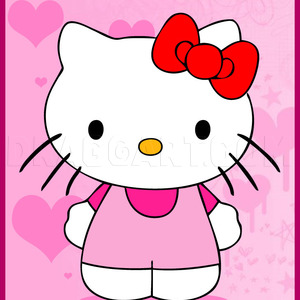1
To start off, we need a round shape for the head, and we'll draw a smaller circle for the nose at the bottom edge.
2
Next we'll add the snout and cheeks, using a series of squat, round shapes. The front shapes are almost rectangular, and each half of the snout angles up and outward from the center.
3
Using rounded rectangles, we'll add the eye holes in the mask. At the top of the head, we'll draw two large ovals angling up and outward to form the ears. Forgive the wobbly lines here.
4
Beneath the snout, we'll draw a U-shape for both the inner and outer edges of the lower jaw. We'll draw a peanut shape for the body. This is a downward angle, so the head will obscure most of the chest.
5
Use simple curves to build the pelvis and shoulders. The arms are going to be draw pointing backward from the body, like he's running at you with his arms just dangling behind. Therefore the shoulders are drawn at a sort of extreme angle.
6
Draw a marshmallow shape for each upper limb. Both arms are at a similar angle. The legs are in a running pose, with one leg coming forward and one going backward or downward. The front leg grows larger at the knee. The other leg grows narrower.
7
More marshmallow shapes for the lower limbs and hands. The hands stick out to the sides at a slight angle from the wrist. The front lower leg appears short because of the downward angle.
8
We'll build the remaining shapes of the feet and fingers with more marshmallow shapes. Then use simple curves to add sections to the ears. With that, all the major shapes are in place and we can focus on the detail from here onward.
9
Lighten the guide drawing, and we'll begin the detail at the top section of the ears. These shapes are a good template for the rest of the body. We have a thick outline with bits of black removed to give it a gritty feel and to remove a bit of that c
10
The lower ears are similar to what we just did, with the addition of the hole in the mask drawn below. From there we can start to outline the main shape of the head.
11
Whenever you're drawing a symmetrical shape like a head or face, it's important to flip your drawing to be sure everything is even. You can do that by flipping your paper and holding it up to a light source. It's really the best way to see if somethi
12
the outlines of the outer shapes are more thick and bold, especially toward the top of the body since it's closer to the "camera," which is us. The inner details of the face and body can be drawn with thinner lines. Even though some of these shapes w
13
After adding the lower set of teeth and filling in the black spaces, I've gone around the head and added detail in the form of scratches, wrinkles and shadows. The top ear sections cast a shadow on the section beneath them. The upper jaw casts a shad
14
So even though we just added a lot of detail, it's important to remember not to go overboard with detail. Especially in something like this, where we're drawing one section of the body at a time. Once you add a lot of detail to one shape, you pretty
15
We're going to use those subtle dash marks again to build shadows on the sides of the head, beneath the cheeks, and beneath the lower jaw (casting down onto the bowtie). There are also some subtle shadow dashes drawn upward from the bottom of the sho
16
I like adding these deep wrinkles to the fabric on the arms and legs. Maybe they sort of look like raisins. I don't know. The point is... leave more open space in the center of each shape, and let the wrinkles grow darker and thicker toward the edges
17
More gnarled marshmallow shapes for the leg and hands. The fingers are drawn as little overlapping, interlocked marshmallows. The hand overlaps the first section of the finger, which overlaps the next. Draw the fingers on each hand at slightly differ
18
We'll use the same techniques from the ears and arms to complete the legs and feet. Simple shapes with uneven outlines, and thin details within. Note the faint edge on the front and sides of the toes. Drawing such a cartoony shape for the feet can re
19
Looking over the image, I can see all the detail kind of exceeded what we did on the face and ears. SO... we'll go back up and revisit those areas, adding faint details to even out the drawing. The face is really our main focal point, so in a lot of
Comments 0
Details
October 19, 2014
Description: Back with another Freddy's tutorial. This time we're drawing a character from a fairly neutral front angle, so I'll discuss using detail to add creepiness to a simple character.


















































































